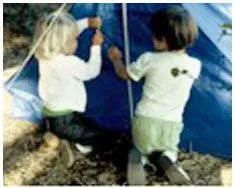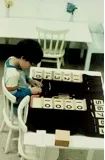Normalization through Work
Among Montessori’s most important educational principles is what she called “normalization.” To understand normalization, let’s go back to what most people think about young children. There is the common idea that young children have a short attention span. They can be naughty and capricious. They leave a trail of messes in their wake. Many of us do not expect that they can learn to read or do math, and we are worried about “pushing” them.
When Mo ntessori began her work with young children, she shared the exact same common prejudices. But as a scientific observer, she felt the need to remain neutral and allow the children to show her what they could do and who they were. What she observed changed her thinking about children forever, and the Montessori Method was born. She spent the rest of her life trying to change what she believed were serious misperceptions about children.
ntessori began her work with young children, she shared the exact same common prejudices. But as a scientific observer, she felt the need to remain neutral and allow the children to show her what they could do and who they were. What she observed changed her thinking about children forever, and the Montessori Method was born. She spent the rest of her life trying to change what she believed were serious misperceptions about children.

She saw that, given the right environment and the freedom to develop at th eir own rate, children are tremendous workers. They have the ability to concentrate on lessons that intrigue them and meet their needs for long periods of time. They learn to choose and repeat the lessons they like. They respect the work of their peers. They calm down and begin to display a joy she had never seen before. Many of them are fascinated with learning to read and write because they want to, not because the teacher expects them to do it.
eir own rate, children are tremendous workers. They have the ability to concentrate on lessons that intrigue them and meet their needs for long periods of time. They learn to choose and repeat the lessons they like. They respect the work of their peers. They calm down and begin to display a joy she had never seen before. Many of them are fascinated with learning to read and write because they want to, not because the teacher expects them to do it.

 Montessori began to realize that she had discovered something of great value. It was not a “method” of educating children; it was the true nature of the child. It was the new “normal.” The restless child who runs around throwing things, hitting others, and causing disruptions is not a satisfied child. Somewhere along the line, some of his needs are not being met.
Montessori began to realize that she had discovered something of great value. It was not a “method” of educating children; it was the true nature of the child. It was the new “normal.” The restless child who runs around throwing things, hitting others, and causing disruptions is not a satisfied child. Somewhere along the line, some of his needs are not being met.


Whether in the home or in school, children need to work on activities that meet their needs for growth and development. We can observe them and set up an environment with appropriate activities, but we cannot dictate what a given child will resonate with. What we do know, from Montessori schools in nearly every country on earth over a period of more than 100 years,  is that when a child does find just the right work that meets his needs, he is transformed.
is that when a child does find just the right work that meets his needs, he is transformed.

The transformation brings the desire to work, ability to concentrate, calmness, joy, and precocity. It takes place when the child finally begins to focus on something. The focus can be anything, from pouring beans to polishing shoes, pitching a tent, doing math, or reading new words.
Let me give you an example. We had a new boy in class. Before this time, nothing in the classroom seemed to interest him. He had just entered school a few months before. He wandered around a lot and did a few lessons when I presented new activities, but nothing seemed to really appeal to him. He made loud noises and generally bothered everyone, including me.
Then one day, a puzzle map caught his attention. He started to do puzzle maps every day. This child did puzzle maps from the time he came in to the time he left, every day for weeks! I was a new teacher. I had been trained that sometimes children picked work and repeated it over and over for some internal satisfaction. But this! I had never seen any child go all out on one material for so long of his own volition.

What was enough? I thought about telling him that it was enough. I tried giving him some other lessons. I called his mother to make sure she knew of his interest and the fact that he was not doing anything else in the classroom. In the end, I just observed and allowed him to work. I made the choice to respect his free choice, which his parents also supported. He was four years and five months old when this cycle began.
Transformation and normalization
After three and a half weeks he stopped. He knew every map by heart. He had learned the names of the countries in most of the continents and could recite the names of the fifty states. That was terrific, but it was not the most important thing. What mattered was the transformation in him. He went from being the proverbial “thorn in my side” to being a settled worker. He went from being a bother to himself and the others in class to being a class helper who was always ready to help one of the younger children. He began to work on lessons in all areas of the classroom. He learned to write and read in a mere three months, and loved to do math lessons. He barely touched the maps for the rest of the year.
This little boy, through his work, became normalized. He was transformed from a distracted child into a calm, industrious lad. Montessori education can transform the children you know, too!
New! From Chaos to Calm: Normalization
Course Sign-Up
Sign Up for our 2 week Montessori online training course
and bring calm to your classroom ...naturally
Offered: October 15 and November 12
 Two Week Course - Special offer: $349
Two Week Course - Special offer: $349

Student Name:
Student Email:
![]()
After purchasing, you will receive a confirmation email containing the information you need to access the From Chaos to Calm: Normalization Course, materials and forum.





















